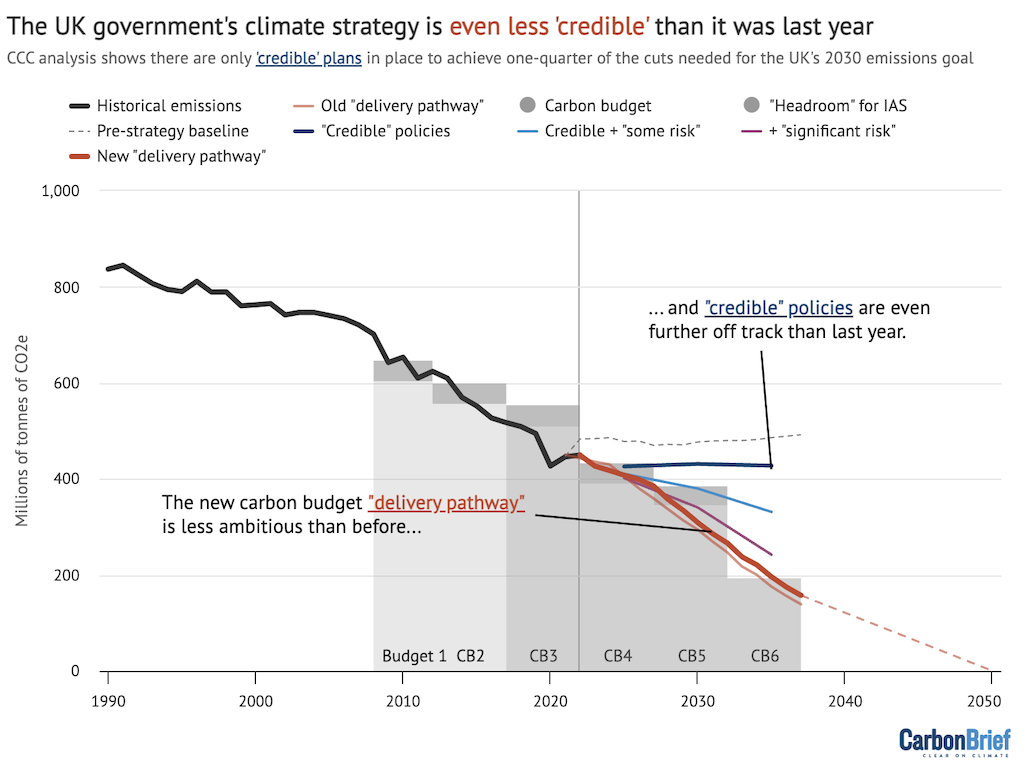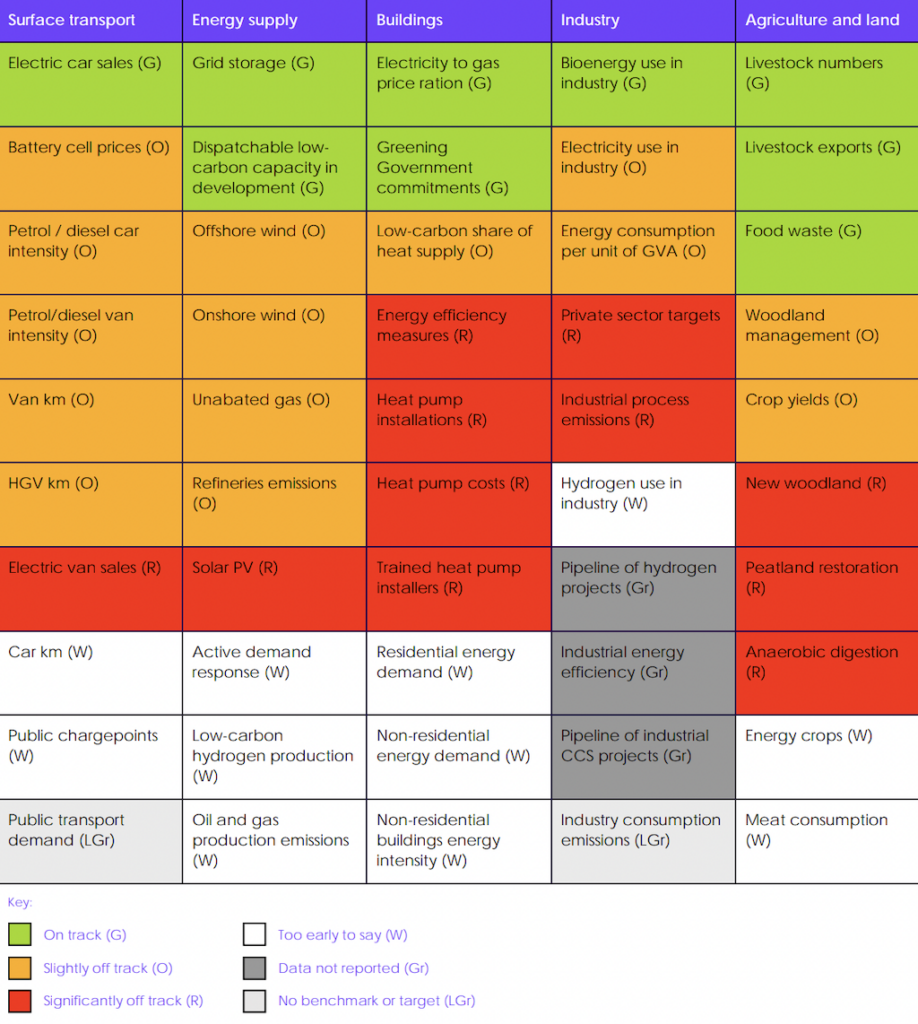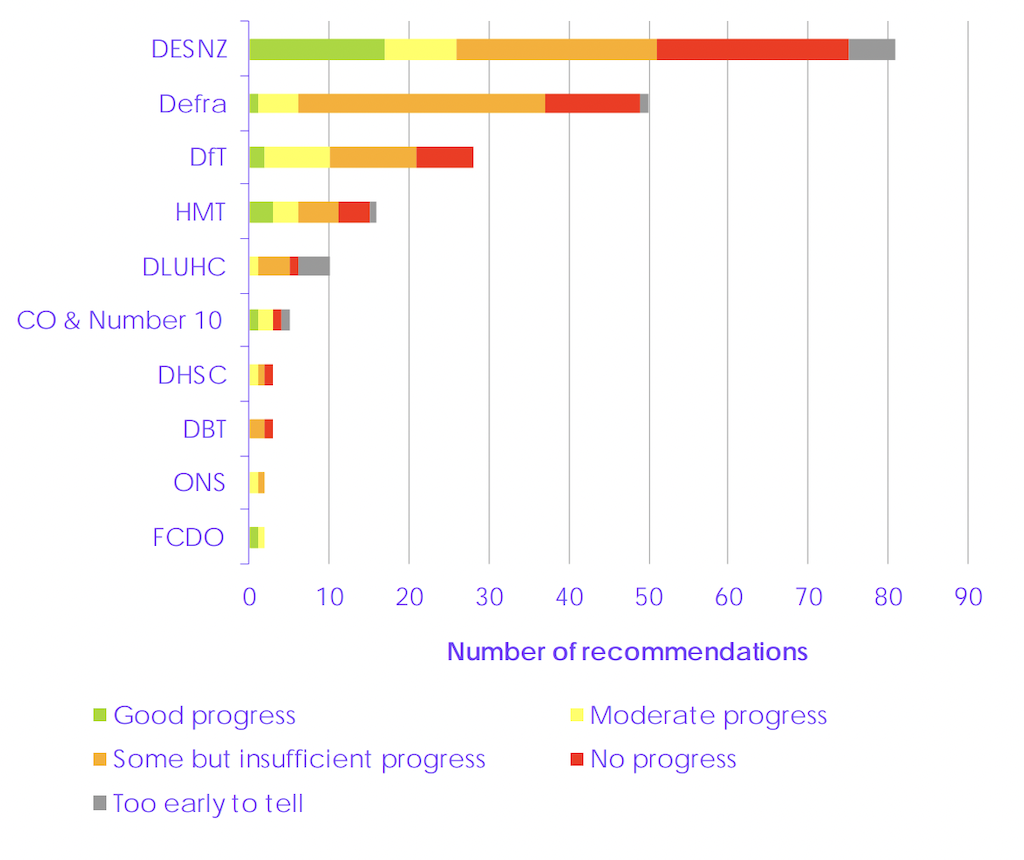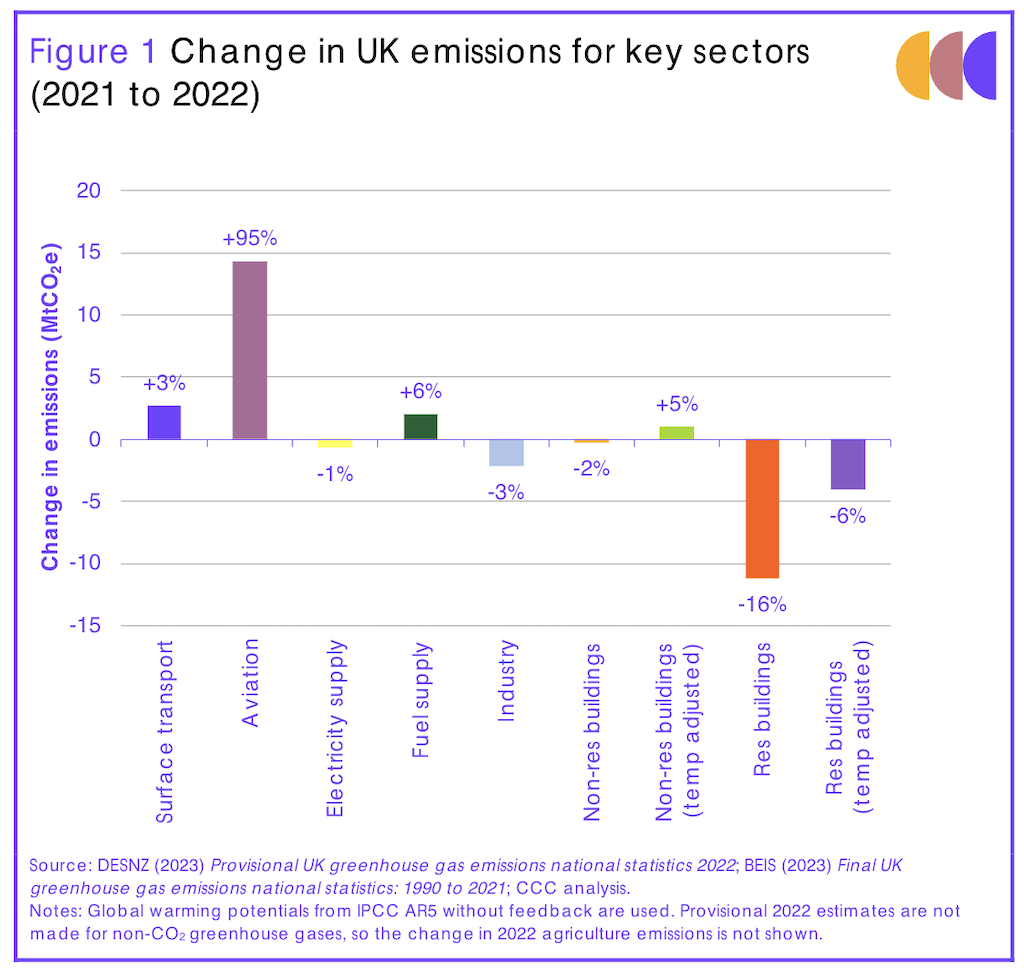Hopes of the UK government meeting its domestic and international climate targets have “worsened” over the past year, according to the Climate Change Committee (CCC).
Its new progress report marks the latest in a series of annual updates, in which the CCC has repeatedly admonished the government for failing to take the action needed to reach its net-zero goals.
It comes in the wake of a High Court ruling that forced the government to provide a far more detailed explanation of how it intends to achieve its legally binding climate targets.
However, rather than setting the nation on a course to hit these goals, the government’s new delivery plan has given the CCC “markedly” less confidence in the UK’s net-zero trajectory.
Last year, it said there were “credible” policies in place to make two-fifths of the emissions cuts needed over the next decade. Now, just one-fifth of those cuts are covered.
Instead, it estimates that existing “credible” climate policies will see emissions flatline – and says only nine out of 50 key indicators are currently “on track”.
Among other things, the UK needs “radical reforms” to its planning policies, controls on the expansion of airports and support for the decarbonisation of heavy industry, the CCC concludes.
In recent weeks, the government has dismissed the opposition Labour party’s plans to end new oil-and-gas licences in the North Sea and described Keir Starmer’s party as being in league with “eco-zealots at Just Stop Oil”.
Yet the CCC states explicitly that “expansion of fossil fuel production is not in line with net-zero” and that, while the UK will still need some oil and gas in the coming years, “this does not in itself justify the development of new North Sea fields”.
Global context
The CCC’s progress report follows the release of the government’s Carbon Budget Delivery Plan (CBDP) in March 2023.
The plan set out the government’s approach to meeting its legally binding carbon budgets and was released as part of a deluge of more than 3,000 pages of documents, after the previous net-zero strategy was ruled unlawful.
The updated strategy included plans and policies sufficient, according to the government’s own modelling, to deliver 97% of the emissions cuts needed to meet the sixth carbon budget, covering 2033-2037.
In its report, the CCC says it welcomes the additional detail included within the CBDP and associated documents. However, it says that it has nevertheless become less confident that the UK will be able to meet its legally-binding goals. (See: ‘Worsening’ policy gap.)
The country’s status as a climate leader is slipping, adds the CCC, driven by a number of key factors including a “wan[ing]” commitment to act since the UK’s presidency of COP26 ended and “hesitation” over key parts of government strategy.
The government response to the fossil fuel price crisis – which provided the backdrop for last year’s progress report – did not embrace the “rapid steps that could have been taken to reduce energy demand and grow renewable generation”, the CCC notes.
Moreover, the CCC says the government has “backtracked” on its fossil fuel commitments over the past year, including with the consenting of a new coal mine in Cumbria and support for new oil and gas production.
This is in spite of the “careful wording” of the Glasgow Climate Pact that the government helped negotiate, the committee adds.
(In a recent factcheck, Carbon Brief examined the impact of banning new North Sea oil and gas licences, a policy supported by the outgoing CCC chairman Lord Deben, whilst the progress report notes that the expansion of fossil fuel production is not in line with net-zero ).
In addition, the UK is yet to truly react to the US Inflation Reduction Act and the EU’s proposed Green Deal Industrial Plan, according to the progress report.
It says the $370bn Inflation Reduction Act will support the development and adoption of low carbon solutions, and has triggered a “green arms race”.
These have provided a “strong pull for green investment away from the UK”, notes the CCC.
Collectively, these elements signify how the UK has lost climate leadership over the past year, the CCC says, even as for many “2022 was the year that climate change arrived” in the form of worsening climate impacts.
The report notes that it was one of the six warmest years on record and the warmest year on record for the UK, with temperatures passing 40C for the first time.
Beyond the UK, floods devastated Pakistan, killing more than 1,700 people and displacing eight million, heatwaves in China led to a drought in the Yangtze River Basin, and an estimated 20,000 people across Europe died of heat-related deaths, the CCC notes.
‘Worsening’ policy gap
The government’s new delivery plan provided a “welcome and significant increase in detail and transparency”, but ultimately “worsened” the outlook for the UK meeting its longer term emissions targets, according to the CCC.
The report concludes that UK greenhouse gas emissions, including international aviation and shipping, were 46% below 1990 levels in 2022. This is a roughly 1% increase from the previous year, but 9% lower than pre-pandemic levels.
The dark red line in the chart below shows that the government’s new “delivery pathway” – the route it says it intends to take to reach net-zero – is actually less ambitious than the one it set out in 2021, shown by the lighter red line.
This is largely because the government expects its policies to be less effective at cutting emissions from road transport, the CCC says.
Overall, the UK would fall short of its 2030 nationally determined contribution (NDC) to the Paris Agreement and its legally-binding sixth carbon budget, the CCC says.

UK greenhouse gas emissions including international aviation and shipping (IAS), millions of tonnes of CO2 equivalent. Lines show historical emissions (black), the pre-strategy baseline (dashed grey) and the UK’s “delivery pathways” outlined in its 2021 net-zero strategy (light red) and its carbon budget delivery plan (dark red). Projected emissions are shown under what the CCC defines as “credible” policies (dark blue); credible policies, plus those with “some risk” (light blue); and policies that are credible, have some risk or “significant risk” (purple). Legislated carbon budgets levels are shown as grey steps. The first five budgets did not include IAS, but “headroom” was left to allow for these emissions (darker grey wedges). Source: CCC progress report. Chart by Tom Prater for Carbon Brief, using Highcharts.
This shortfall has been acknowledged by the government, which expects future “unquantified” emissions cuts to make up the gap.
However, the CCC emphasises that when existing policies are assessed for their credibility, a much larger shortfall emerges. Overall, it says the government is “missing coherent plans” and remains “over-reliant” on “specific technological solutions”.
It notes that the UK is now more likely to achieve its fourth carbon budget between 2023 and 2027 than it was last year, largely due to an increase in electric-vehicle sales and less road traffic following the Covid-19 pandemic.
But the CCC says its confidence in the government achieving its sixth carbon budget and NDC target has dropped “markedly” since 2022.
This is attributed to a combination of greater transparency, which allowed the committee to make a more detailed long-term assessment of the government’s plans and policies, as well as “delays in action leading to increased delivery risk”.
Government plans deemed “credible” by the CCC will now achieve emissions cuts just 49% below 1990 levels by 2035, compared to 55% in last year’s assessment.
These policies cover roughly one-fifth of the emissions cuts required to hit the sixth carbon budget, down from two-fifths last year.
As the chart above shows, UK emissions would essentially flatline for the next decade, if only “credible” policies are implemented and achieved.
With seven years to go until the NDC target, the report notes that “credible” plans cover just 25% of the emissions reductions needed to achieve it.
(The committee also assesses the proportion of emissions that have “some risks” or “significant risks” attached to them, as well as those that have “insufficient plans”. Overall, more emissions have missing or inadequate plans than in the 2022 assessment.)
The CCC repeats its “monitoring framework” from last year, noting that while there have been “some positive developments” action has been “significantly off track”.
In keeping with the greater transparency since the government’s carbon budget delivery plan, the committee notes that there are more targets in place than last year.
However, of the 50 key indicators identified in the report, there are now 25 identified as “significantly” or “slightly” off track, compared to 14 in the previous assessment. In contrast, it says progress against only nine of the 50 indicators is currently “on track”.
These indicators can be seen in the grid below.

Expansion of renewable power and the phaseout of coal have contributed to the majority of emissions cuts over the past few decades. This is alluded to in a government statement released in response to the CCC’s criticism, with a spokesperson stating:
“The UK is cutting emissions faster than any other G7 country and attracted billions of investment into renewables, which now account for 40% of our electricity.”
However, as the CCC stresses once again, the UK will need to decarbonise more than its power sector in order to achieve its emissions targets.
As the grid above shows, there are significant gaps in the transport, buildings, industry and agriculture sectors that need to be filled, according to the committee.
The report concludes that outside of the electricity supply sector, emissions cuts must almost quadruple from annual reductions of 1.2% between 2014 and 2022 up to 4.7% on average, between 2022 and 2030.
Even in the power sector, progress has begun to slow down. The CCC says there are “some risks” attached to a much larger proportion of renewables goals than last year, “predominantly due to the continued absence of a delivery strategy for the sector and increased delivery risks around planning, consenting and access to network connections”.
The CCC also assesses the progress made by individual government departments.
As the most significant department for the net-zero transition, the Department for Energy Security and Net Zero (DESNZ) has the largest number of missed recommendations from the list issued by the CCC last year.
However, the report singles out the Department for Environment, Food & Rural Affairs (Defra) and the Department for Levelling Up, Housing and Communities (DLUHC), which have “failed to achieve any priority recommendations and have made insufficient or no progress on a large majority of the non-priority recommendations”.
This lack of departmental progress can be seen in the chart below.

Overall, the CCC points to a “lack of urgency” in the four years since the government committed to its net-zero goal and concludes:
“The slow progress to date on delivery towards net-zero means that it is no longer tenable for the government to develop strategies that do not contain committed policies.”
Electricity
Emissions from the electricity sector in the UK fell by just 1% in 2022, compared with a year earlier, despite increases in renewable electricity capacity, the CCC says.
It attributes this to the UK being a net exporter of electricity in 2022, for the first time in 44 years. Electricity generated for export to continental Europe, where the French nuclear fleet was suffering major outages, meant higher than expected emissions in the UK, it explains.
While the precise impact of the additional gas power plants running for export purposes is hard to quantify, notes the CCC, it estimates that electricity supply emissions might otherwise have been around 6% lower in 2022.
The limited reduction in electricity emissions is shown in the figure below.

Power prices reached unprecedented levels in 2022, leading the government to step in with a number of support mechanisms for households and businesses.
One such measure was the government taking on the costs of climate and social policy – including support for low-carbon electricity and insulation for fuel-poor homes – which had previously been paid for via electricity bills.
By paying for these costs – often referred to as “green levies” – the government effectively cut the ratio of electricity prices to gas prices.
According to the CCC, it is now “essential that this improvement in relative prices is made permanent,” helping to rebalance electricity and gas prices, which the government has already committed to implement by March 2024.
(Media reports over the weekend indicate that, on the contrary, the government intends to reapply policy costs to consumer electricity bills from July, despite having pledged last autumn to pay for levies out of general taxation for two years.)
Mirroring many other concerns from the CCC, action to decarbonise the electricity sector is not moving fast enough according to the progress report, with deployment rates falling short of what is required by the government’s stretch targets, in particular for solar.
Despites an increase in renewable electricity capacity in 2022, the UK government missed an opportunity for rapid deployment of onshore wind and solar, which could have both increased clean energy supply and helped to reduce the country’s dependence on imported fossil gas, the CCC notes.
To enable this, however, planning policy needs “radical reform to support net-zero,” says the CCC. There is currently a risk of the net-zero transition being “stymied or delayed by restrictive planning rules”, it adds.
This is already becoming evident with regards to the capacity of electricity networks in the UK, with renewable developers facing waits of 10-15 years for a grid connection.
Sharelines from this story
- SEO Powered Content & PR Distribution. Get Amplified Today.
- PlatoData.Network Vertical Generative Ai. Empower Yourself. Access Here.
- PlatoAiStream. Web3 Intelligence. Knowledge Amplified. Access Here.
- PlatoESG. Automotive / EVs, Carbon, CleanTech, Energy, Environment, Solar, Waste Management. Access Here.
- BlockOffsets. Modernizing Environmental Offset Ownership. Access Here.
- Source: https://www.carbonbrief.org/ccc-chance-of-uk-meeting-climate-pledges-has-worsened-since-last-year/



